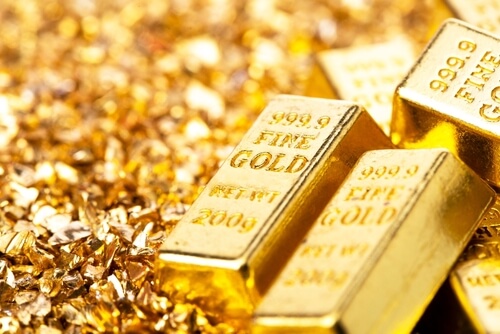Gold prices posted a modest rebound below the critical support mark in early Asian trade on Thursday after sticky inflation in the US led to some selling of the yellow metal, although lower bond yields and a sliding dollar may provide a slight aid to the markets.
Spot gold was trading 0.02% higher at $1,993.22 per ounce, while gold futures for April gained 0.03% to $2,004.90 per ounce.
Spot gold fell below the $2,000 psychological level for the first time since mid-December on Tuesday, while the two instruments also dropped more than 1% in the day. Analysts had cautioned of further possible losses following the decline from the closely-watched support threshold.
Adding pressure to the yellow metal the day earlier was the US dollar hitting a three-month high of nearly 105.00 before it tumbled 0.02% to 104.70 on Thursday. US Treasury notes stumbled as well, with the 10-year yield trading at 4.23%.
Senior strategist James Stanley stated that gold’s potential next psychological mark was at $1,975 to $1,978 per ounce, considering it was the last support level reached by the yellow metal before the Federal Reserve’s meeting in December.
Spot gold was last trading 0.03% lower at $1,991.73 per ounce, while gold futures stood 0.05% lower at $2,003.20.
Hot CPI Weakens Early Fed Rate Cuts, Gold Outlook Uncertain
The US consumer price index (CPI) data easing at 3.1% in January ended stronger than expected, reinforcing the Fed’s case to keep interest rates higher for longer.
Fed Vice Chair for Supervision Michael Barr said the Federal Open Market Committee (FOMC) remained optimistic about inflation in the world’s largest economy being on track to touch the central bank’s annual 2% target.
Still, according to Barr, the Fed would require additional positive data confirming that inflation is moving toward the target before it can start cutting interest rates.
Barr also endorsed a cautious approach to rate reductions and policy normalization, seeing current circumstances.
Following the remarks, the CME FedWatch tool showed traders had lowered their bets for easing federal funds rates in May and June, but they continued to price in a 51% probability for a 25 basis point (bp) cut in June.
However, extending higher interest rates is unfavorable to gold, as it dents demand for non-yielding metals, strengthening competition from higher-yielding instruments. Such a scenario has capped any significant increases in prices of the yellow metal in the last two years.
In recent sessions, gold’s progress beyond $2,050 has been curbed, although it was able to rise around 10% in 2023.
Markets now shift their focus on the US retail sales data due later in the day, which is expected to log a month-over-month (MoM) slide of 0.2% in January.
Traders also await further cues from speeches of Atlanta Fed President Raphael Bostic and Fed Governor Christopher Waller, both set for Thursday.











